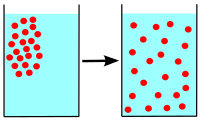
Photo from wikipedia
The atomization and the spray characteristics from an effervescent/aerated strut injector were studied experimentally using water as the liquid and nitrogen gas as the secondary fluid. The spray flow features… Click to show full abstract
The atomization and the spray characteristics from an effervescent/aerated strut injector were studied experimentally using water as the liquid and nitrogen gas as the secondary fluid. The spray flow features were obtained through various experimental tools such as instantaneous Mie scattering technique, phase Doppler particle analyzer, and time-resolved shadowgraph images for different Weber numbers, momentum flux ratios, and gas to liquid ratios. A proper orthogonal decomposition method was used for an in-depth analysis of the spray structures. The instantaneous Mie scattering images showed the formation of the liquid clusters and the dominant two-phase flow interaction with increasing momentum flux and gas to liquid ratios in addition to the increased spray spread area. The statistical analysis of the Mie images revealed high fluctuating locations in the spray. It was observed that by increasing the momentum flux or gas to liquid ratios, the droplet diameter rapidly decreases due to the flow transition to the annular flow regime. Beyond a certain limit of momentum flux or gas to liquid ratios, no significant change in the diameter was observed. Furthermore, the spatio-temporal fluid dynamic features and the two-phase flow transition inside the spray region were brought out through the proper orthogonal decomposition. The power spectral density revealed the ligament breakup and the droplet formation below ≤500 Hz. Regardless of the momentum flux and gas to liquid ratios, a peak was observed between 2500 Hz and 3000 Hz due to the flow transition where the liquid fragment cluster formation and the flapping were found to be almost constant.
Journal Title: Physics of Fluids
Year Published: 2021
Link to full text (if available)
Share on Social Media: Sign Up to like & get
recommendations!